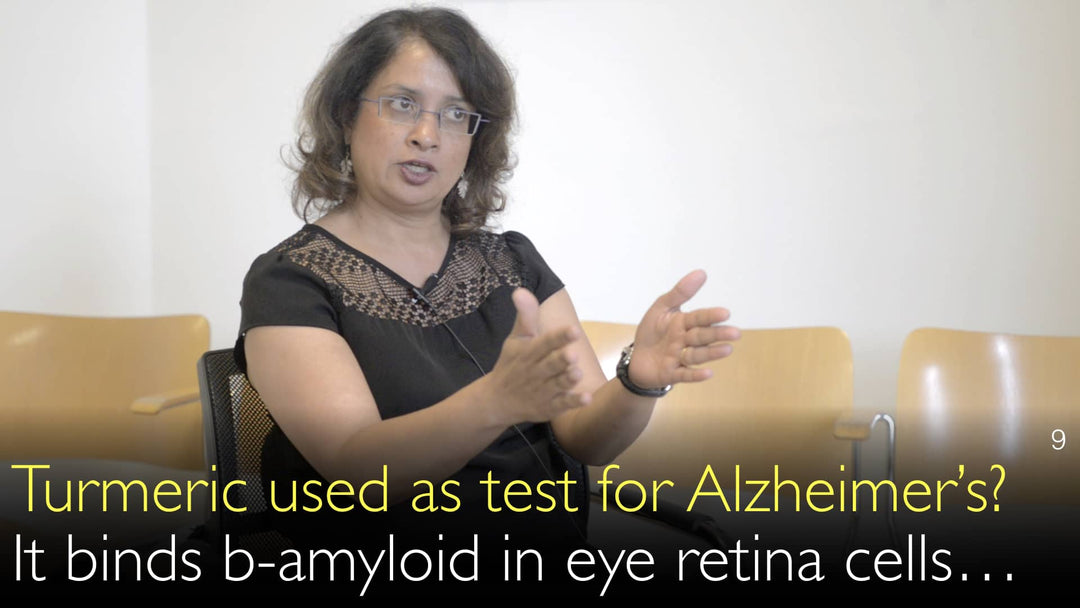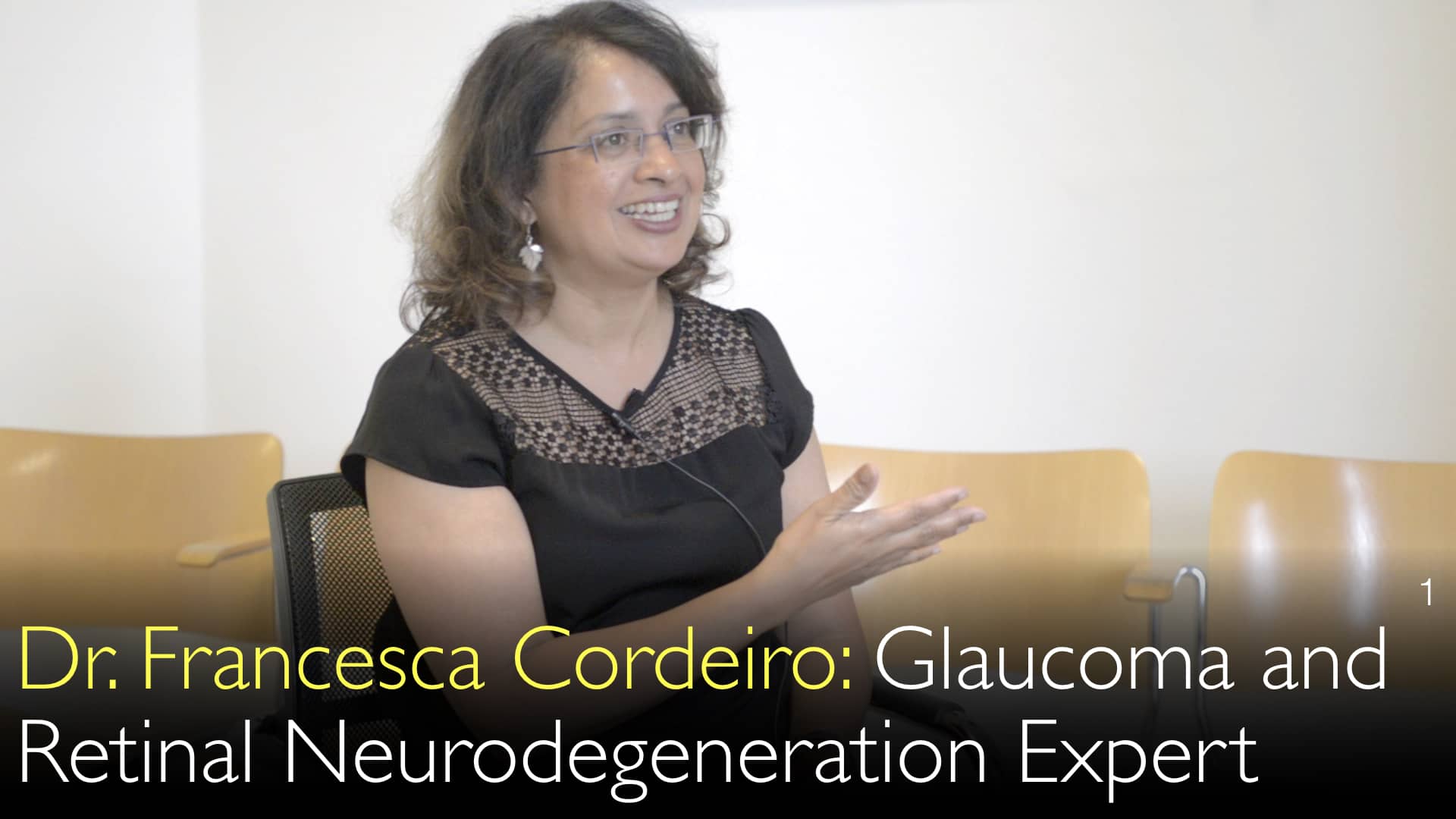Dr. Francesca Cordeiro, MD, en førende ekspert inden for neurodegenerative øjensygdomme, forklarer, hvordan en ny øjetest kaldet DARC (Detection of Apoptosing Retinal Cells) kan revolutionere tidlig diagnosticering af Alzheimers sygdom. Denne ikke-invasive ambulante procedure bruger fluorescerende øjendråber baseret på curcumin til at påvise døende nerveceller i nethinden og beta-amyloid-plader. Dette kan give et indblik i hjernens patologi år før kliniske symptomer opstår. Dr. Cordeiro fremhæver testens betydning, ikke kun for at identificere personer med øget risiko, men også for at fremskynde kliniske forsøg markant ved at levere en hurtig biomarkør til at måle behandlingseffekt ved både Alzheimers og Parkinsons sygdom.
Tidlig Alzheimers-diagnose: Revolutionerende øjetest opdager neurodegeneration
Spring til afsnit
- DARC-øjetesten for Alzheimers sygdom
- Nethinde-hjerne-forbindelsen ved neurodegeneration
- Sådan detekterer curcumin-fluorescens amyloid
- Ambulant diagnostisk procedure
- Fremskynder Alzheimers kliniske forsøg
- Overvågning af behandlingsrespons
- Anvendelser ved Parkinsons sygdom
- Fremtidigt diagnostisk potentiale
DARC-øjetesten for Alzheimers sygdom
DARC-testen (Detection of Apoptosing Retinal Cells) er et gennembrud inden for preklinisk detektion af Alzheimers sygdom. Dr. Francesca Cordeiro, MD, forklarer, at denne innovative øjetest identificerer døende nerveceller – en proces kaldet apoptose – i nethinden. Denne celledød er en afgørende tidlig begivenhed i neurodegeneration. At kunne opdage disse forandringer i øjet giver et unikt vindue for tidlig intervention, længe før der opstår signifikant hjerneskade eller kliniske symptomer på Alzheimers.
Nethinde-hjerne-forbindelsen ved neurodegeneration
Nethinden er udviklingsmæssigt en forlængelse af hjernen, hvilket gør den særligt modtagelig for de samme neurodegenerative processer. Dr. Francesca Cordeiro, MD, bemærker, at nerveceller i nethinden kan begynde at dø år før nervecelleted er påviselig i hjernen. Denne tidlige apoptose i nethinden kan markere starten på klinisk Alzheimers sygdom. Derudover viser patienter med Alzheimers unormale aflejringer af beta-amyloidprotein i nethinden, hvilket afspejler de patologiske plader, der findes i hjernen.
Sådan detekterer curcumin-fluorescens amyloid
Testen anvender curcumin, et naturligt stof udvundet af gurkemeje. Dr. Francesca Cordeiro, MD, beskriver den centrale mekanisme: Når curcumin binder til beta-amyloidprotein, begynder det at fluorescere – det udsender lys. Denne fluorescens fungerer som en lys markør, der gør det muligt for læger at identificere amyloidplader i nethinden under en standard øjeskanning. Derved får man et direkte og observerbart tegn på Alzheimers sygdoms patologi på cellulært niveau.
Ambulant diagnostisk procedure
En stor fordel ved denne diagnostiske tilgang er dens praktiske anvendelighed. Dr. Francesca Cordeiro, MD, forklarer, at testen er designet som en simpel ambulant procedure. I stedet for en injektion har hendes team udviklet en curcumin-baseret øjendråbe. En læge kan give dråben og derefter bruge almindeligt scanningudstyr fra øjenklinikker og optikere til at detektere fluorescensen. Det gør testen både tilgængelig og ikke-invasiv for patienterne.
Fremskynder Alzheimers kliniske forsøg
En af de mest betydningsfulde anvendelser af teknologien er inden for farmaceutisk forskning. Dr. Francesca Cordeiro, MD, fremhæver et stort problem ved Alzheimers: Kliniske forsøg tager ekstremt lang tid at afgøre, om en ny medicin virker, fordi forandringer i hjernen er meget subtile og langsomme. Denne øjetest kan forkorte tidsrammen ved at levere en hurtig biomarkør. Ved at måle niveauet af retinal celledød kan forskere få et tidligt indikation af, om en terapi effektivt bremser neurodegeneration.
Overvågning af behandlingsrespons
Testen kan også revolutionere, hvordan behandlingssucces måles hos den enkelte patient. Dr. Cordeiro foreslår at etablere et udgangsniveau for apoptotisk aktivitet – fx 20 til 30 døende nethindeceller – når en patient først diagnosticeres. Efter start på en effektiv behandling bør antallet af disse fluorescerende pletter, der indikerer celledød, falde. Dette fald fungerer som et klart, tidligt tegn på, at Alzheimers-behandlingen virker, længe før forbedringer ses i kognitive tests eller hjernescanninger.
Anvendelser ved Parkinsons sygdom
Testens anvendelighed strækker sig ud over Alzheimers sygdom. Dr. Francesca Cordeiro, MD, bemærker, at hendes team har publiceret resultater med DARC-teknologien i eksperimentelle modeller for Parkinsons sygdom. De viste, at succesfuld behandling får niveauet af retinal apoptose til at falde, længe før der ses forandringer i hjernens substantia nigra – det område, der primært påvirkes af Parkinsons. Dette bekræfter testens rolle som en følsom og tidlig indikator for behandlingsrespons ved neurodegenerative sygdomme.
Fremtidigt diagnostisk potentiale
Selvom potentialet er stort, understreger Dr. Francesca Cordeiro, MD, at disse fund skal valideres i store populationsbaserede kliniske forsøg. Målet er at bekræfte testens evne til at identificere patienter med høj risiko for Alzheimers og pålideligt overvåge terapeutiske resultater. Som Dr. Anton Titov, MD, diskuterer med Dr. Cordeiro, kunne denne teknologi revolutionere diagnostik og behandling af neurodegenerative sygdomme og give håb om tidligere intervention og bedre behandlingsmuligheder.
Fuld transskription
Preklinisk detektion af Alzheimers sygdom er afgørende for tidlige behandlingstilgange. Den nye øjetest, DARC (Detection of Apoptosing Retinal Cells), finder døende nerveceller i øjets nethinde. Øjet udvikler sig fra hjernen, og nethinden påvirkes af neurodegeneration. Curcumin (gurkemeje) fluorescerer, når det binder beta-amyloid. Amyloid aflejres i nethinden og hjernen ved Alzheimers sygdom.
Nerveceller i nethinden kan være i færd med at dø i årevis.
Dr. Anton Titov, MD: Det sker, før nerveceller begynder at dø i hjernen. Dette kunne betyde starten på klinisk Alzheimers sygdom.
Dr. Francesca Cordeiro, MD: Ja, absolut, det er hypotesen. Men der er også anden forskning i gang. Vi ser også på dette. Nogle gange kan man lede efter beta-amyloid i plader, der aflejres i nethinden. Det ses i transgene Alzheimers-modeller, som er eksperimentelle musemodeller.
Grøn stær og Alzheimers sygdom påvirker begge nethinden. Patienter har unormalt aflejret beta-amyloid i nethinden. Man kan observere beta-amyloid i nethinden med fluorescerende markører. Vi ved, at gurkemeje binder beta-amyloid. Gurkemeje er det orange krydderi, der bruges meget i currys. Når gurkemeje binder beta-amyloidprotein, fluorescerer det. Så i nethinden kan man opsamle fluorescensen. Det er en markør for beta-amyloidprotein, der aflejres i nethinden.
Der er flere data, der tyder på betydningen af disse retinale forandringer. Det kunne fremhæve død af neuroner i nethinden, før de overhovedet sker i hjernen. Men disse fund skal vurderes korrekt i store populationsbaserede kliniske forsøg. Potentielt kunne denne øjetest for Alzheimers sygdom være en ambulant test.
Dr. Anton Titov, MD: Du kan udføre denne diagnostiske test med udstyr, der findes hos øjenlæger og optikere. Du injicerer simpelthen farvestoffet under passende forhold.
Dr. Francesca Cordeiro, MD: Vi udviklede en øjendråbe. Så en læge er i stand til at gøre dette på en ambulatorieklinik. Ved at bruge øjendråber og en standard scanning kan man potentielt identificere patienter, der har højere risiko for Alzheimers sygdom.
Dr. Anton Titov, MD: Dette kan udvælge patienter med Alzheimers sygdom til tidlig behandling. Ja. Men måske en anden, mere forestillelig tidlig fordel ved dette ville være at bruge denne "Alzheimers øjetest" til at vurdere respons på behandling af Alzheimers sygdom. Det er meget svært i behandling af Alzheimers sygdom at vide, hvordan en patient reagerer på terapi.
En potentiel test til at diagnosticere et preklinisk stadium af Alzheimers sygdom er at se på, hvordan celler dør i nethinden. Det er testen, der gennemgår kliniske undersøgelser nu. Men et af de største problemer i kliniske forsøg med Alzheimers sygdom er, at det tager lang tid at afgøre, om en medicinkandidat virker eller ikke, på grund af de meget subtile forandringer ved Alzheimers sygdom.
Testen, du har udviklet, kan potentielt revolutionere diagnostikken af Alzheimers sygdom. Den kan også komprimere tidsrammen for kliniske forsøg med Alzheimers-terapi.
Dr. Anton Titov, MD: Vil du venligst tale om betydningen af din test for Alzheimers sygdom?
Dr. Francesca Cordeiro, MD: Denne diagnostiske test er ikke kun til klinisk praksis, som vi lige diskuterede, men også til medicinske kliniske forsøg ved Alzheimers sygdom. Ja. Vi har også publiceret testresultater i en Parkinsons sygdomsmodel.
Hvad vi foreslår, er, at du kan bruge niveauet af apoptose – hvor du ser disse fluorescerende pletter i nethinden – som et mål for Parkinsons sygdomsaktivitet. Hvis du behandler din patient succesfuldt, bør denne Parkinsons sygdomsaktivitet falde. Antallet af celler med apoptose i nethinden bør falde.
Vi har vist dette i en række øjensygdomsmodeller. Den eksperimentelle model for Parkinsons øjensygdom har bestemt antydet dette. Du kan bruge dette som en indikator for, om din Parkinsons-behandling er succesfuld. Du ser behandlingsresultater meget tidligere, end du kan se forandringer i hjernen.
I denne særlige undersøgelse med Parkinsons-modellen viser vi, at retinal apoptose faldt længe før hjern…





